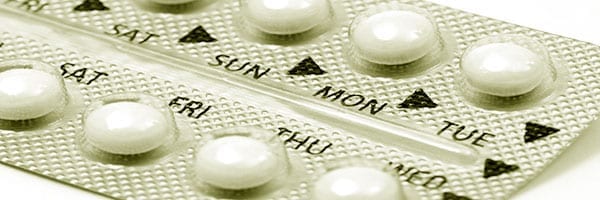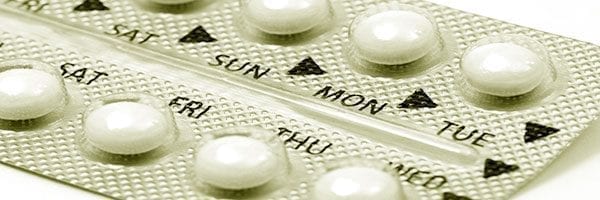The typical medical treatment for endometriosis provided by most OBGYNs consists of manipulating a woman’s hormones, primarily her estrogen and/or progesterone levels. The rationale behind this treatment is that estrogen tends to stimulate the growth of endometriosis and progesterone is believed to balance or stabilize the effect of estrogen. In a very simple example, one can think of estrogen as fertilizer for the lawn and progesterone as the lawn mower. The goal of medical treatment of endometriosis is to increase the ratio of progesterone to estrogen (progesterone-only treatment), decrease the amount of both estrogen and progesterone (combinational birth control pills) or to eliminate estrogen from the body (GnRH agonist treatments such as Lupron and Zoladex).
Unfortunately, all hormone therapies commonly employed to treat endometriosis are fairly crude and are frequently associated with unacceptable side effects, making these medications difficult to tolerate. Some patients find the side effects even more debilitating than the symptoms of the disease itself. Hormone therapies do not provide a cure for the disease, are only effective in a portion of endometriosis patients, and even when this treatment option provides relief the results are typically short-lived and symptoms return. Furthermore, hormone therapies are not appropriate in patients presenting with infertility or who are trying to conceive. Even use of a GnRH agonist such as Lupron that causes a temporary medical menopause is frequently ineffective in managing endometriosis as endometriotic tissue itself can produce its own source of estrogen, allowing it to remain active and symptomatic despite the treatment.
When should hormone therapies be considered?
If hormone therapies are only temporarily effective in some patients and do not make the endometriosis go away nor necessarily stop the disease in its tracks (treating the symptoms but not the disease), why are they so commonly prescribed?
When a patient first presents with pelvic pain, and in particular period pain, the doctor and patient face a dilemma: How long should her symptoms be managed symptomatically (via medical therapy) and at what point should more invasive treatment options be considered (such as laparoscopic surgery) to actually diagnose and treat any underlying disease? On the one hand the patient wants to avoid unnecessarily invasive treatments and the risks associated with surgery (albeit minimal,) yet on the other hand she also wants to get to the root of her problem so that it can be effectively treated and she can get on with her life. This is obviously a very personal decision that needs to be made based on the severity of symptoms and the individual needs and priorities of the patient. Importantly, however, the patient needs to be informed of her options so that she can play an active role in the decision-making process.
Prescribing hormone therapies requires limited expertise and is a treatment option that is readily available to all. Surgery, in contrast, may require a level of expertise that most OBGYNs do not have. Moreover, if a patient is presenting with erratic and painful menstrual periods, a prescription of birth control pills may lighten, regulate and shorten her periods, easing her pain. It is when a patient keeps returning to her doctor complaining of the same symptoms despite trying different hormone therapies or cannot tolerate the side effects, that it is time to consider other treatment options.
Adenomyosis
A condition that is common among women with endometriosis is adenomyosis. Adenomyosis is when endometriotic tissue is found within the muscular walls of the uterus. Typically these areas of rogue tissue are scattered diffusely throughout the muscular uterine walls and so are not amenable to surgical removal. Endometriosis patients who also have suspected adenomyosis may find that some of their pelvic pain persists despite endometriosis excision surgery. While surgery to destroy or sever the nerves that innervate the uterus may help reduce this residual uterine pain, in most cases the only curative surgery for adenomyosis is hysterectomy (removal of the uterus). Obviously, many women will not be a position to undergo hysterectomy because they wish to retain their fertility. In these patients, conservative management of the chief symptoms of adenomyosis (pain and abnormal uterine bleeding) with hormone therapy provides an important alternative.
Pre-operative ovarian suppression
Another example where hormone therapy may be appropriate is in managing pain in patients who are waiting for surgery. For example, a teenage patient who plans her surgery during her school vacation so as not to disrupt her studies may benefit from hormone therapy to manage her symptoms and help her function in the mean time. Importantly, however, it is best that the patient is not on ovarian suppressive therapy shortly before or at the time of her surgery as this can hamper the surgeon’s ability to visualize all areas of disease. Ideally, all ovarian suppressive therapy should have be discontinued 6-8 weeks prior to surgery.
Should hormone therapies be prescribed following surgery to prevent recurrence?
If a patient has undergone the complete surgical removal of her endometriosis and her pain has been resolved there is no clinical indication for continued use of hormone therapies (other than for contraceptive purposes). Post-operative hormone therapy has not been found to reduce the rate of symptom nor disease recurrence. Recurrence of endometriosis rarely occurs following the complete excision of the disease regardless of whether the patient follows up surgery with hormone therapy.
Post-operative ovarian suppression following cystectomy
Some surgeons recommend post-operative hormone therapy following endometrioma (cystic ovarian endometriosis) removal (cystectomy) with the hope that ovarian suppression will reduce the risk of recurrence of the endometrioma(s). Research into this, however, has been inconclusive. Another reason for post-operative ovarian suppression following endometrioma removal is to give time for the ovary to heal before ovulation recommences, which might otherwise cause additional pain during post-operative healing.
Further reading
For more information on different types of hormone therapy, common side effects and their efficacy in treating endometriosis and adenomyosis,, check out Dr. Cook’s in-depth patient guide to hormone therapy treatments.






My daughter is 24 years old and has been suffering from endometriosis. She was recently diagnosed in early November, but has been having severe menstrual pain for years. The disease has attached to her rectum and vagina and of course in excruciating pain. Her surgery is finally scheduled for January 29th, but will have to have a colonoscopy first. I am very concerned about the powerful drugs they will be prescribing to put her in menopause. The idea of a 24 year old going through menopause is heart-breaking. This disease has taken over my child’s life and while her spirits are up most times, she feels like her life is in suspended animation due to this disease. And of course, the possibility of infertility is an issue for her because she is an only child and has always wanted a lot of children. What do you recommend?
Permalink
I am 33yrs, 2009 I had my tweens thru surgery, since then my period has been hell, i've gone from one hospital to another hospital but no one seems to know what was roungh with me. 2017 a doctor said it's endo and refers me to a specialist were in had surgery, after the surgery they gave me zoladex injection for 3 month, after 2 month the pain came back worst than before, I've been going to the hospital since then but they only gave me pain relief drugs yet the pain is too unbearable pls what do I do I'm tired and confused pls help me